In educational background, Liang Piyun and I are quite similar. While he spent his secondary education at Jimei Zhongxue· (Jimei High School), in Xiamen, then studied at Wuchang Shida· (Wuchang Normal University), obtained his Bachelor of Arts degree from Shanghai Daxue· (Shanghai University) and finally pursued his postgraduate studies at Waseda University, Japan, I completed my primary schooling at the private Wang· family clan school Ziliujing· (Shuren School), in Ziliujing,· Sichuan· province, then studied at the Luzhou Chuannan Lianhe Xianli Shifan Xuexiao· (Luzhou United County Normal School), audited at Wuchang Shhida· (Wuchang Normal University), graduated from Shanghai University and finally also pursued my postgraduate studies in Japan. However, owing to varying circumstances, social conditions and temperaments, there have been far too many differences between our achievements, by which I mean our respective contributions to and influence on society.
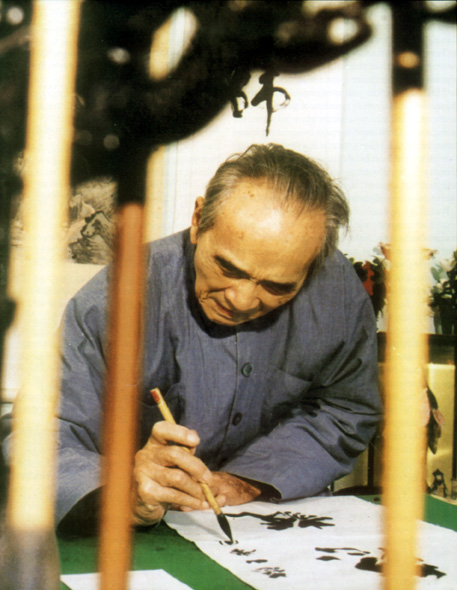 Liang piyun 梁披云 writing one of his poems.
photograph taken in the 1980's.
Liang piyun 梁披云 writing one of his poems.
photograph taken in the 1980's.
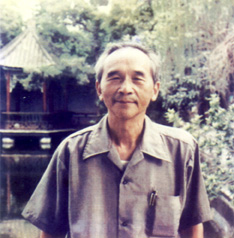 Liang Piyun 梁披云 in the Lou Lim lok Garden, 卢廉若 in Macao.
Photograph taken during the mid 1980's.
Liang Piyun 梁披云 in the Lou Lim lok Garden, 卢廉若 in Macao.
Photograph taken during the mid 1980's.
Personally, I consider my primary schooling to have been quite perfect. Towards the end of the reign of the Emperor Guangxu· [r. 1875- † 1908] of the Qing dynasty [1644-1912], Shuren School was run by the well-known Wang family clan. Mostly educated in Japan, the principals of the school were the descendants of the local landlord and salt merchant. A few Japanese scholars were also hired to teach at the school, which had a secondary section and offered courses in teacher training in addition to Fine Arts, Gymnastics, and other subjects. The school was located in Bancangba,· later renamed the city of Zigong,· in Ziliujing,· which had the largest saltworks in Sichuan province. Many of the teachers — I still remember one by the name of Xie Huisheng· and another called Cao Shushi· — and students who once taught and studied at the school later became important political or academic figures in China.
[...]
Liang Piyun entered Shanghai University a little earlier than I did. While he majored in Chinese Literature, probably with Ding Ling· as his classmate, I entered the Shehuixue xi· (Department of Social Sciences), headed by Qu Qiubai, · with Yang Hansheng,· Li Shuoli,· Yang Zhihua,· Zhong Fuguang,· Zhao Juntao,· Guo Bohe,· and others, as my classmates — some of whom were actively involved in the students' movements against the British and the Japanese. I was a member of the Gongtuan Lianhehui· (Workers' Association) and taught at Pudong Gongren Zidi Xuexiao· (Pudong Workers' Children School). I often met Guo Bohe (who was assigned to Shanghai by Li Lisan,· Secretary of the Zonggonghui· (General Trade Union)) in workers' homes. Several activists of the students' movement led by Shanghai University were slaughtered in the 'Wusa Yundong'· ('May 30th Massacre'). We also started a newspaper called "Zhengyi Ribao"· ("Justice Daily"). At that time, I had no idea what Liang Piyun was doing, but I knew that he was associated with a young worker's organisation led by Lu Bum.·
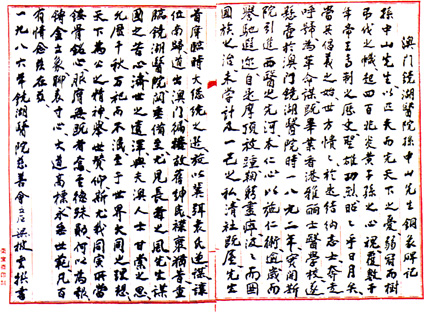 Writing by Liang Piyun 梁披云 in memory of Sun Zhongshan 孙中山, · inscribed on a tablet at the stand of his bronze statue, unveiled in 1986, in the Kiangwu Hospital 镜湖医院, Macao.
Writing by Liang Piyun 梁披云 in memory of Sun Zhongshan 孙中山, · inscribed on a tablet at the stand of his bronze statue, unveiled in 1986, in the Kiangwu Hospital 镜湖医院, Macao.
At the time of joining Shanghai University, the Zhongwen xi· (Chinese Department) was headed by Chen Wangdao· and numbered amongst its staff such renowned associates as Shen Yanbing,· Zheng Zhenduo, · Yu Pingbo· and Liu Dabai.·
[...]
There, Liang Piyun developed a very close friendship with the veteran educator Professor Shen Zhongjiu,· from whom the former benefited greatly. Whilst teaching at Shanghai University, Shen Zhongjiu was already making preparations to establish his ideal school - the Lida Zhongxue· (Lida Secondary School).
[...]
It was through Liang Piyun that I got to know Shen Zhongjiu, who had also studied in Japan (he translated Karl Marx's The Communist Manifesto from Japanese into Chinese while there) and was a great friend of Chen Wangdao's.
[...]
During his stay in Shanghai, Shen Zhongjiu's humble apartment at Xiaoximen· became a meeting place for young people like Wu Langxi,· Lang Wei,· Wu Kegang,· Li Feigan,· and, of course, Liang Piyun. Shen Zhongjiu's educational ideal blended Confucianism, western learning and advocated the 'education of love'. Various Western schools of thought had already been introduced into China by that time, Dewey's philosophy being very much in vogue. The Lida Secondary School founded by Shen Zhongjiu, Kuang Husheng,· Feng Zikai,· and others, later renamed Lida Xueyuan· (The Lida Garden of Learning) to distinguish itself from other schools, adopted collective leadership, discarding the post of principal, and upheld 'free, liberal education'.
[...]
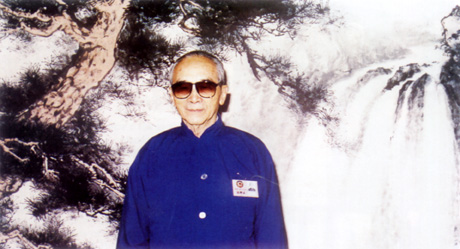
Liang Piyun 梁披云 in the Renmin Dahuitang 人民大会堂 (Great Hall of the People), in Beijing.
Photograph taken in 1995. Photograph taken in 1995.
In 1925, in the "Jiaoyu Zazhi"· ("Education Journal" — vol. 17, issue 6), Shen Zhongjiu wrote that although the founders of the Lida Garden of Learning differed from one another in character and background and learning, they unanimously detested and condemned autocracy and oppression. They all felt that"[...] schools nowadays are run too much like states, depending on authorities and laws for survival. [...] Today, schools chum out mechanical tools, slaves, and not free human beings. [...] Teachers merely want their students to abide by the rules and regulations,obey orders and respect teachers' authority, [...]." The founders of Lida Garden of Learning, firmly believing that"[...] the main objective of education is to develop students' individuality, which is preconditioned by an atmosphere of liberty, run the school on the principle of complete respect for individual will and freedom."
The leaders of Garden of Learning also had a completely different view of the so-called 'quanren jiaoyu'· ('whole-person') or 'ziyou jiaoyu'· ('all round') theory of student development: "[...] they all claim that they are training students for their intellectual, moral, physical, and aesthetic, etc., development, but actually they only concentrate on the intellectual aspect. [...] Genuine education must inspire students with ideals and the enthusiasm to change reality and strive for the realisation of those ideals."
Clearly influenced by his teacher, Shen Zhongjiu, Liang Piyun later established Liming Gaozhong· (Liming High School), where he had more success in putting his ideals into practice. Recalling the school's inaugural ceremony in October 1929, Liang Piyun remarked: "I still remember writing two couplets for the inauguration of Liming High School:
“这不是学校,宇宙才是真正学校;
我们并没有家庭,学校便是大众的家庭。”
("This is not a school; the Universe is our real school;
We are homeless, and yet the school is home to all of us.").
And:
“小爷气、小姐气、书呆气、流氓气、根本要不得;
平民化、社会化、艺术化,著手做起来。”
("Do away with princelings and bookworms; We nurture love for the people, society and the arts.").
[...]
The school's staff constantly strive to realise the ideals contained in these verses. However, in doing so, are they upholding the principles of their forerunners at the Lida Garden of Learning?
Liang Piyun once served as Director of Education for Fujian· province and, although he is now more than eighty years old, he is still as dedicated as ever to the cause of promoting education. Currently he is busy developing Liming Daxue· (Liming [Vocational] University), the educational establishment of his dreams and ideals.
[...]
I wish him every success in his future endeavours.
New Orleans, 10th July 1989**
Translated from the Chinese by: Ieong Sao Leng, Sylvia 杨秀玲 Yang Xiuling
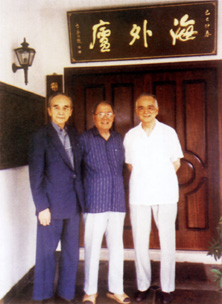
Left to right: Liang Piyun 梁披云, Liang Lingguang 梁灵光 (Liang Piyun's brother) and Pan Shou 潘受 (poet and calligrapher), in Singapore.
Photograph taken in 1994.
* Historian, born in Fushun,· Sichuan.· Graduated from Shanghai Daxue· (Shanghai University) in the 1920's and went on to take post-graduate studies in Japan. Lived for a number of years in Taiwan· and presently resides in New Orleans in the United States of America.
** Abridged version.
start p. 245
end p.